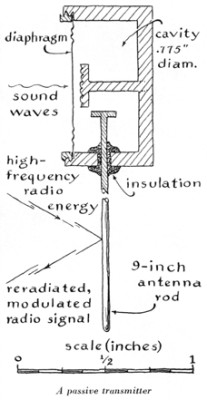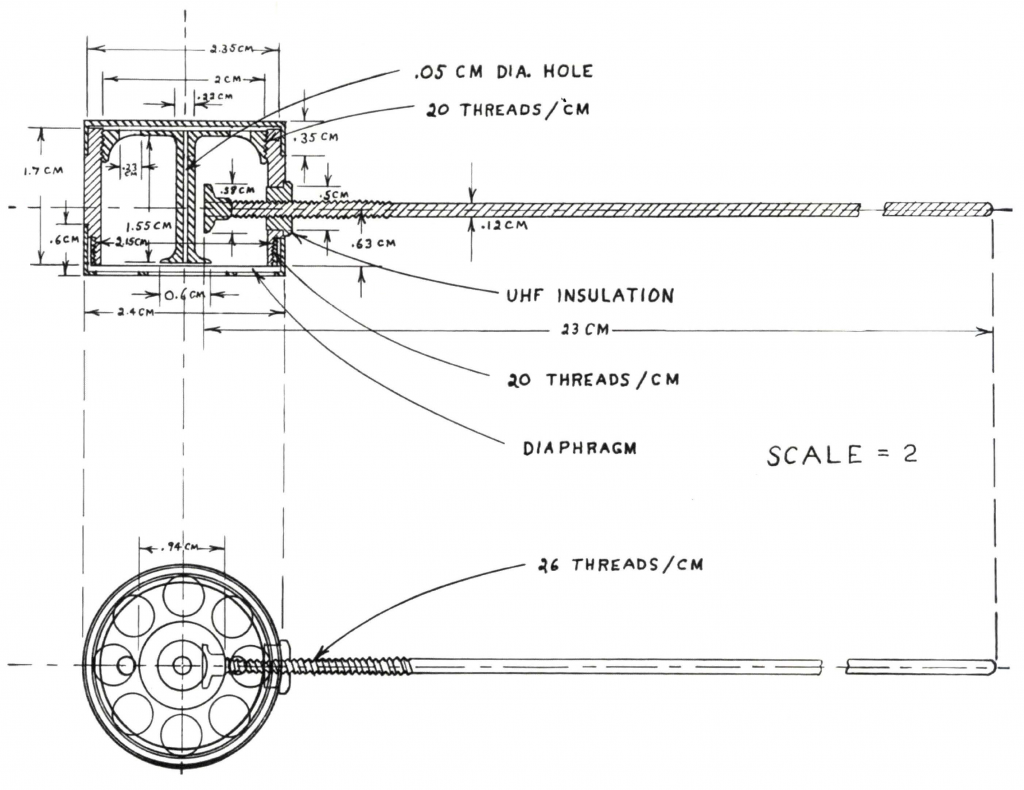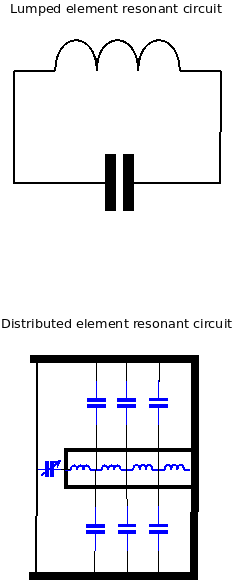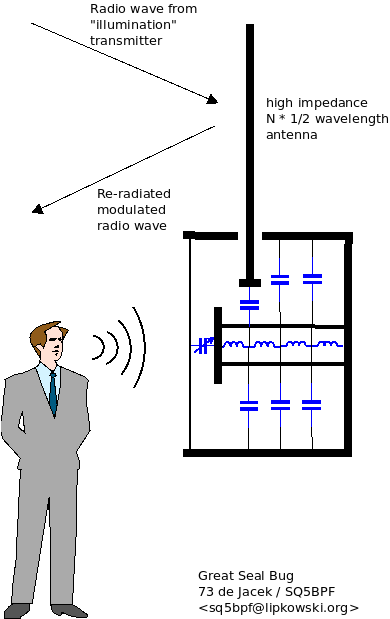This is the second part of articles about the Great Seal Bug (also called “The Thing”). These articles will cover: history, theory of operation and a practical reconstruction of this device.
This part is a short explanation the theory of operation.
The FBI has unclassified the initial report about the Great Seal Bug [3]. It has a lot of construction details, including most dimensions:
The “great Seal Bug” is a resonant circuit made from distributed elements. The following diagram shows a simple lumped element resonant circuit, and a distributed element resonant circuit (with the distributed capacitance and inductance shown in blue):
Such a distributed element circuit can have very low losses, and therefore a high Q factor. Most losses are due to resistive losses and the skin effect, these losses can be made very low by using thick conductors (lots of surface area) and low resistive loss material (copper, preferably silver plated for even lower loss).
The Great Seal Bug consists of a metal cylinder, with a metal rod inside, this is the resonant circuit. One side of the can is a conductive membrane, which is used as a microphone membrane. An antenna is capacitively coupled to this resonant circuit.
The capacitance between the membrane and the rod in the center of the bug varies with the membrane position (which is moved by sound). Changes in the capacitance vary the resonant frequency of the circuit.
A N * 1/2 wavelength antenna is capacitively coupled to the resonant circuit (the designers of the Great Seal Bug used N=3, so the antenna was 3/2 wavelengths long). Such antennas have very high input impedance, and thus don’t need a big counterpoise, the metal cylinder is more than adequate.
This antenna is “illuminated” by a carrier wave from a radio transmitter on a frequency near the resonance frequency of the tuned circuit. Some portion of this energy is re-radiated from the antenna. The amount of the re-radiated energy depends on the impedance presented by the tuned circuit. This impedance changes by a large amount, because this circuit is near resonance.
So the method of operation is as follows:
- As the metallic membrane vibrates, it changes distance from the inner rod.
- This change in distance causes a change of capacitance to the inner rod.
- The change of capacitance changes the resonant frequency of the tuned circuit.
- This causes great changes to the impedance of this tuned circuit at the “illumination frequency”.
- Changes to this impedance vary the amount of the re-radiated radio wave
- The result can be seen as AM (amplitude modulation) and some PM (phase modulation) of the re-radiated radio wave. In practice only the AM component is used.
This leads to the following design principles:
- The distance from the metal membrane to the inner rod should be very small, because this results in the biggest capacitance changes when the membrane is vibrated. According to [1] the distance was 0.23mm.
- The electrical properties (impedance) at the illumination frequency of the tuned circuit should vary greatly when the resonant frequency changes. So this needs to have a high Q. High Q can be achieved when low loss materials are used, so preferably the elements (including the inner side of the membrane) should be silver-plated.
- The membrane should move as freely as possible, so it should be very thin (6.35um according to [1]). Also the metal cylinder should have a hole on the back side, so that the membrane is not damped by an air cushion.
This device is has a lot of advantages to the eavesdropper:
- No power supply is needed, so the device can work forever.
- Low probability of detection using 1950’s technology. When there is no illumination signal, not signals are transmitted back
- Low probability of detection using 1970’s technology – the non-linear junction detector, because there are absolutely no semiconductors inside [2]
Author: Jacek Lipkowski SQ5BPF
Literature:
[1] https://www.cryptomuseum.com/covert/bugs/thing/
[2] https://en.wikipedia.org/wiki/Nonlinear_junction_detector
[3] https://www.cryptomuseum.com/covert/bugs/thing/files/GREAT_SEAL_BUG.pdf



